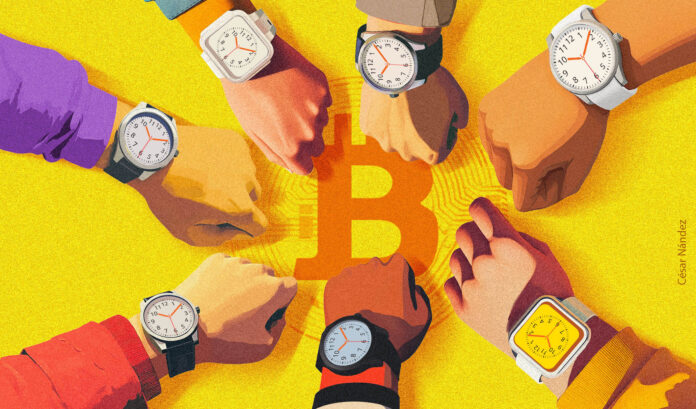
We are entering spring in the Northern Hemisphere and autumn in the South. Although time may seem one of the most stable conventions, the history of the standard for measuring it is far from linear—shaped instead by political interests, practical needs, and a constant tension between power and convenience. At a time when many international agreements appear to be unraveling—from trade deals to principles of multilateral cooperation—it’s worth taking a moment to consider how and why certain universal standards managed to take hold.
Historically, the railway played a key role in the standardization of time, distributing a unified schedule to each destination to improve the predictability of transportation and communication. Before this, each city set its clock according to solar noon. Over time, countries adopted different time zones, driven partly by convenience, necessity, and also political motivations.
The impact of politics on the adoption of standards is clear in history. Spain, for instance, adopted Central European Time in 1940 by order of Franco to align with Germany, despite its geographic position suggesting it should be in another zone. China, nearly as vast as the United States, operates on a single time zone to unify its vast territory. Energy crises have also triggered changes in national time policies to make better use of daylight. In Argentina, this happened during the presidency of Alfonsín and again during the gas crisis under President Néstor Kirchner, when the province of Mendoza shifted its time.
The Quest for Standards and Global Consensus
Throughout history, humanity has developed mechanisms to facilitate coexistence and cooperation. The standardization of systems and measures has been key to the development of complex societies, enabling more efficient communication and reducing costs and conflict.
Many current standards—such as the calendar, weights and measures, or currencies—emerged from prolonged processes of cooperation. In some cases, these agreements were explicit between countries and institutions; in others, they were imposed by empires or governments, or simply adopted informally due to convenience.
The case of Esperanto is an example of a failed attempt at standardization. Designed as a neutral universal language, it never gained traction due to a lack of widespread adoption. In contrast, certain systems have become global standards. A clear example is traffic lights: although traffic laws vary, the color code is nearly universal, eliminating the need for negotiation at every intersection. That said, a fully international driver’s license still doesn’t exist—some are recognized in specific countries through particular procedures.
In some cases, mechanisms have been designed to allow compatibility between different systems. For example, the docking modules of the International Space Station are built to connect spacecraft from different countries, and railway networks have devised ways to operate across regions with differing track gauges.
The Standardization of Weights, Measures, and Calendars
In ancient times, each region had its own units of measure, which made trade and communication difficult. The length of a foot or the weight of a pound varied significantly between cultures. The need to unify these measures led to more coherent systems, such as the Metric System in the 18th century, which facilitated international trade and scientific collaboration. Today, conversions between metric and imperial systems have been implemented, such as in product labeling in Europe.
One of the most widely adopted standards is the Gregorian calendar, which corrected an 11-minute annual drift in the Julian calendar. Though its adoption was not simultaneous across the globe, it eventually became the global standard, reflecting the influence of centralized decisions in the standardization process.
Standards in Technology, Music, and Navigation
Music also offers examples of standardization. The tuning of A to 440 Hz was established in 1939 as an international standard, enabling collaboration among musicians from different regions.
In navigation, the IALA maritime buoyage system, established in 1957, sought to unify signal criteria. However, two systems still exist: System A, used in Europe, Africa, and Asia (except Japan, Korea, and the Philippines), and System B, adopted in the Americas.
Technology has seen its own battles for standardization, with examples like the PAL and NTSC television systems, differences in electrical voltages (110V vs. 220V), and various plugs and connectors for electronic devices. However, some standards have achieved global adoption, such as the Internet Protocol (IP) and the GSM system in mobile telecommunications.
Bitcoin: A Decentralized Monetary Standard?
Standardization has been a key tool in solving practical problems and facilitating international cooperation. We’ve seen some standards emerge from centralized decisions. Others have evolved in a decentralized way based on utility and convenience.
Since its emergence in 2009, Bitcoin has positioned itself as an alternative to traditional currencies, offering a decentralized network outside the control of any central authority. Its potential to become a universal currency will depend on its ability to achieve a consensus comparable to that of the Gregorian calendar or the metric system. However, it faces challenges such as volatility, political regulations that may restrict its use, and the technological infrastructure required to support it.
The Future of Consensus
While history shows that politics has been a determining factor in the adoption of standards, modern technology and communication offer greater transparency and flexibility in decision-making. In the case of time zones, any arbitrary decision can lead to practical issues—such as flight schedule errors or problems programming devices. Likewise, the adoption of a decentralized currency like Bitcoin could redefine global monetary consensus, as long as it can overcome its current hurdles.
Just as debates around international trade are resurfacing—with the return of tariffs fueled by Trump’s announcements—the fragility of certain previously unquestioned agreements is becoming evident. In this context, rethinking how global standards are formed and maintained is increasingly relevant.
The future of global standardization and consensus remains open. What is certain is that, as in the past, a mix of domestic politics, global strategy, cooperation, and technology will continue to shape how we organize our world—perhaps with our clocks synchronized toward greater transparency and control.
*Machine translation proofread by Janaína da Silva.


